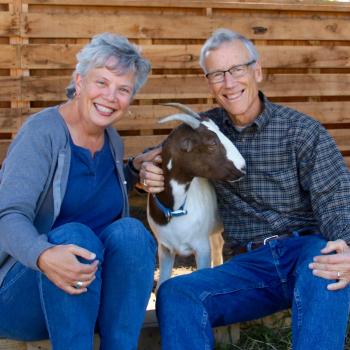Today’s post is a sermon I gave yesterday at my home church, Trinity Episcopal in Iowa City.
Gospel Reading: John 20:19-31
When it was evening on the day of Resurrection, the first day of the week, and the doors of the house where the disciples had met were locked for fear of the Jews, Jesus came and stood among them and said, “Peace be with you.” After he said this, he showed them his hands and his side. Then the disciples rejoiced when they saw the Lord. Jesus said to them again, “Peace be with you. As the Father has sent me, so I send you.” When he had said this, he breathed on them and said to them, “Receive the Holy Spirit. If you forgive the sins of any, they are forgiven them; if you retain the sins of any, they are retained.”
But Thomas (who was called the Twin), one of the twelve, was not with them when Jesus came. So the other disciples told him, “We have seen the Lord.” But he said to them, “Unless I see the mark of the nails in his hands, and put my finger in the mark of the nails and my hand in his side, I will not believe.”
A week later his disciples were again in the house, and Thomas was with them. Although the doors were shut, Jesus came and stood among them and said, “Peace be with you.” Then he said to Thomas, “Put your finger here and see my hands. Reach out your hand and put it in my side. Do not doubt but believe.” Thomas answered him, “My Lord and my God!” Jesus said to him, “Have you believed because you have seen me? Blessed are those who have not seen and yet have come to believe.”
Now Jesus did many other signs in the presence of his disciples, which are not written in this book. But these are written so that you may come to believe that Jesus is the Messiah, the Son of God, and that through believing you may have life in his name.
——————————————————-
Is there any figure in the Bible who’s easier to relate to than Doubting Thomas? It’s no wonder the phrase has become part of the English language as a term for a skeptic.
Through the centuries, theologians have taken two general approaches to this story of Thomas demanding physical evidence for the resurrection of Jesus. The first group—who have tended to be Roman Catholic—have emphasized the fact that while Jesus says it’s best to believe on the basis of faith alone, he nevertheless was willing to show Thomas his wounds. Some Christians have taken this as a blessing for such practices as the veneration of relics and going on pilgrimages. The second group of theologians—who have tended to be Protestant—say not so fast, for the story’s point is that we are to rely on faith alone.
And then we have the contemporary, secular interpretation, which is that belief is pretty much impossible, not matter what the circumstances. To illustrate this, let me tell you of the experience of Barbara Ehrenreich, social activist and author of books that include Nickel and Dimed. Her newest book, Living with a Wild God: A Nonbeliever’s Search for the Truth about Everything
, tells about her quest to make sense of the mystical encounters she has had since the age of 17. Throughout her life she has had ecstatic experiences in which the whole world seems to be aflame and alive with a mysterious presence. Here’s her description of one of these experiences:
At some point in my pre-dawn walk … the world flamed into life. [There was a] blazing everywhere. Something poured into me and I poured out into it… It was a furious encounter with a living substance that was coming at me through all things at once.
Ehrenreich’s mystical encounter is similar to those reported by many saints and holy people through the centuries. But her reaction is modulated through the lens of our rational, skeptical culture. These experiences are something of an embarrassment for an educated person, especially one who has always professed to be an atheist. When asked by an interviewer if she now believes in God, Ehrenreich dismisses the possibility by saying this:
I would not explore the monotheistic religions. The religions that impress me are those which involve ecstatic communion with a deity or spirit—like voodoo. I like that much better than belief. I have respect for that. But…I’m not looking for anything, and I’m not going to church.
Or, as she put it in another interview, “Don’task me to believe anything.”
Don’t ask me to believe anything. That’s the line I keep coming back to. For in our culture, religious belief is often seen as a sign of ignorance. And I have to wonder, what does it take for someone like Ehrenreich to believe in God? If seeing the world on fire and alive doesn’t do it, what will? And what hope is there for the rest of us, who go through our days with no mystical visions or spiritual fireworks?
But the irony is, we may say we don’t believe in anything beyond the rational and scientific, but we do. For you can’t be human without operating on faith. Think of the beliefs that many of us have. If I do everything right as a parent, my child will be successful and happy. If I eat the right foods and exercise intensely, I will be in perfect health and live to an advanced age. If I could make another $20,000 or $50,000 or $100,000, then I would be totally happy and secure. Frankly, we have faith in a lot of things that make the virgin birth seem like not very much of a stretch.
Over the past few years, some of the most interesting adult forums at Trinity have been part of the “This I Believe” series. Inspired by the NPR series of the same name, they have featured some wonderfully thought-provoking discussions. I remember listening to parishioners who believe in the scientific method, the importance of myth, and the value of poetry in times of war. Their stories have given deep insights into their lives and beliefs.
As Christians, of course, there are many religious beliefs that we are supposed to ascribe to. But on any given morning, you might be surprised by what your fellow parishioners are thinking. I wish that we were more honest with each other about our struggles to believe. I’m amused by the number of Episcopalians, for example, who have told me that they have trouble saying the Nicene Creed. They’ll say: “I just keep silent on the parts I don’t believe in” or “I quietly change some of the words.” Someday I’d like to make a T-shirt similar to Robin Williams’ Top 10 Reasons to be an Episcopalian. The T-shirt would have on it the text of the Nicene Creed, with all sorts of crossed out words and changes scratched in the margins. And the top of the shirt would read: “You Might Be an Episcopalian if You Think the Nicene Creed Needs an Editor.”
Part of what we love about our church, of course, is the value we place on reason. But as with Thomas in the Gospel story today, sometimes our rational minds tie us into knots.
If I were asked to speak at adult forum as part of the This I Believe series, I would focus on a line in our Sunday morning service that I think is the single most audacious and revolutionary thing we say. When Lay Eucharistic Ministers are commissioned to go out with their little boxes of blessed bread and wine, we say this: We who are many are one body, because we all share in the cup of blessing and the one bread.
This is pretty strange, isn’t it? For it’s obvious that even on a symbolic level, we’re not one body. But the statement claims that we are indeed one—Democrats and Republicans, male and female, altar guild members and toddlers in the Zookeepers young families group. This claim goes far beyond the walls of this church, too, for it includes southern Pentecostals, Nigerian Baptists and Chinese Catholics. It includes cradle Episcopalians and those who are visiting a church for the first time. And this sort of radical inclusiveness was present from the very beginning of our faith, when Jesus broke the rules of his day by insisting that everyone was welcome at his table—prostitutes and rich men, tax collectors and Pharisees.
Perhaps belief is best thought of as action rather than as intellectual assent, which is actually far more in keeping with the Biblical witness. Your belief is expressed in showing up here on a Sunday morning even when you’d rather be at home. It’s revealed in your willingness to bring your squirming children and feed them Cheerios in the pew. Sometimes the most profound statement of faith we can make is simply showing up at the door of the church.
I like how the philosopher Stanley Hauerwas puts this: “I am not interested in what I believe,” he says. “I am not even sure what I believe. I am much more interested in what the church believes.”
Let me give you an example of what this looks like in action. Several years ago I was contacted by someone who had heard about our Healing Touch ministry. Their infant daughter was in intensive care at the UI Hospital because of complications after a heart operation, and the parents asked us to see her. So a small group of us did so nearly every day for six weeks. During that time we became close to the parents, who were far away from their family and friends.
When it became clear that their baby daughter would not recover, the parents asked me to be with them in her last hours. Let me tell you what I was not thinking as I made my way to the hospital. I wasn’t thinking pious thoughts or planning how I would put this loss in a theological context. Instead I was worried that I was going to be such a teary, emotional mess that I would not be any help at all. I felt like anything I could say was a platitude and totally inadequate.
So at the baby’s bedside, I latched onto the Book of Common Prayer. While I had no words to say, within its pages I found words that had been polished and worn smooth by being prayed so many times. I remember how grateful I felt that I didn’t have to do this on my own. More importantly, the baby’s parents didn’t have to do it on their own. The words of the service for the dying became the boat that helped them cross over to that new, foreign country where they would no longer have their daughter.
As we stood there in that sterile hospital room under the fluorescent lights, I gradually came to feel something unexpected. I began to have the slightly uncanny sense that we were not alone, that all of the people who had prayed those words before us were there too, living and dead, and that our grief was being enfolded in something that is the closest thing I have ever experienced to the Body of Christ.
So that is what I think of on a Sunday morning when we say “we who are many are one body.” That is why I believe that when we say the Nicene Creed, and some of us can’t say the part about the virgin birth and others stumble over true God from true God, it somehow equals out. Because together, our words make a whole. And I am grateful that on those Sunday mornings when I’ve feeling distracted, or grumpy, or cynical, I can look out in the congregation and I always—always—see someone whose face reflects the peace that passes all understanding. And I know that on that morning, that person is making up for what I lack.
And let me assure you also that there are some mornings when I can breeze through the Nicene Creed and believe every single word, things seen and unseen, begotten not made, God from God, Light from Light. On those mornings, I’ve got it covered for you . . . You’re welcome.
So we muddle through, most of us. Because somehow, together we are more than we are separately. This is the single best argument I can make for coming to church, for why we need more than individual mystical experiences like those of Barbara Ehrenreich. For we who are many are one body, even when we struggle to believe.











